ZooKeeper介绍 (https://www.cnblogs.com/h--d/p/10269869.html)
ZooKeeper是一个分布式的,开放源码的分布式应用程序协调服务,是Google的Chubby一个开源的实现,是Hadoop和Hbase的重要组件。它是一个为分布式应用提供一致性服务的软件,提供的功能包括:配置维护、域名服务、分布式同步、组服务等。
ZooKeeper的目标就是封装好复杂易出错的关键服务,将简单易用的接口和性能高效、功能稳定的系统提供给用户。
ZooKeeper包含一个简单的原语集, [1] 提供Java和C的接口。
官网:https://zookeeper.apache.org
ZooKeeper安装
安装环境:
1、系统:CentOS 7.4
2、Java环境:JDK8
zookeeper有单机、伪集群、集群三种部署方式,本例使用的zookeeper版本是:zookeeper-3.4.12
单机模式
1、下载ZooKeeper,地址:http://mirrors.hust.edu.cn/apache/zookeeper/
注意版本,启动报错可能找不到主类,可以下载源码版
2、解压,命令:tar -zxvf zookeeper-3.4.12.tar.gz -C /data/soft/
解压后目录如下:

3、进入conf目录,创建一个zookeeper的配置文件zoo.cfg,可复制conf/zoo_sample.cfg作为配置文件
命令:cd conf
命令:cp zoo_sample.cfg zoo.cfg

配置文件说明:
1 # The number of milliseconds of each tick 2 # tickTime:CS通信心跳数 3 # Zookeeper 服务器之间或客户端与服务器之间维持心跳的时间间隔,也就是每个 tickTime 时间就会发送一个心跳。tickTime以毫秒为单位。 4 tickTime=2000 5 6 # The number of ticks that the initial 7 # synchronization phase can take 8 # initLimit:LF初始通信时限 9 # 集群中的follower服务器(F)与leader服务器(L)之间初始连接时能容忍的最多心跳数(tickTime的数量)。 10 initLimit=5 11 12 # The number of ticks that can pass between 13 # sending a request and getting an acknowledgement 14 # syncLimit:LF同步通信时限 15 # 集群中的follower服务器与leader服务器之间请求和应答之间能容忍的最多心跳数(tickTime的数量)。 16 syncLimit=2 17 18 # the directory where the snapshot is stored. 19 # do not use /tmp for storage, /tmp here is just 20 # example sakes. 21 # dataDir:数据文件目录 22 # Zookeeper保存数据的目录,默认情况下,Zookeeper将写数据的日志文件也保存在这个目录里。 23 dataDir=/data/soft/zookeeper-3.4.12/data 24 25 26 # dataLogDir:日志文件目录 27 # Zookeeper保存日志文件的目录。 28 dataLogDir=/data/soft/zookeeper-3.4.12/logs 29 30 # the port at which the clients will connect 31 # clientPort:客户端连接端口 32 # 客户端连接 Zookeeper 服务器的端口,Zookeeper 会监听这个端口,接受客户端的访问请求。 33 clientPort=2181 34 35 # the maximum number of client connections. 36 # increase this if you need to handle more clients 37 #maxClientCnxns=60 38 # 39 # Be sure to read the maintenance section of the 40 # administrator guide before turning on autopurge. 41 # 42 # http://zookeeper.apache.org/doc/current/zookeeperAdmin.html#sc_maintenance 43 # 44 # The number of snapshots to retain in dataDir 保留数量3 45 autopurge.snapRetainCount=3 46 # Purge task interval in hours 47 # Set to "0" to disable auto purge feature 清理时间间隔1小时 48 autopurge.purgeInterval=1 49 50 51 # 服务器名称与地址:集群信息(服务器编号,服务器地址,LF通信端口,选举端口) 52 # 这个配置项的书写格式比较特殊,规则如下: 53 54 # server.N=YYY:A:B 55 56 # 其中N表示服务器编号,YYY表示服务器的IP地址,A为LF通信端口,表示该服务器与集群中的leader交换的信息的端口。B为选举端口,表示选举新leader时服务器间相互通信的端口(当leader挂掉时,其余服务器会相互通信,选择出新的leader)。一般来说,集群中每个服务器的A端口都是一样,每个服务器的B端口也是一样。但是当所采用的为伪集群时,IP地址都一样,只能时A端口和B端口不一样。
4、可以不修改zoo.cfg,默认配置就行,进去zookeeper安装目录,启动ZooKeeper
启动命令:./bin/zkServer.sh start
停止命令:./bin/zkServer.sh stop
重启命令:./bin/zkServer.sh restart
状态查看命令:./bin/zkServer.sh status
伪集群模式
伪集群模式就是在同一主机启动多个zookeeper并组成集群
1、在同一台主机上,通过复制得到三个zookeeper实例
![]()
2、对三个zookeeper节点进行配置
zookeeper1配置文件conf/zoo.cfg修改如下:
1 tickTime=2000 2 initLimit=5 3 syncLimit=2 4 dataDir=/data/soft/zookeeper-cluster/zookeeper-3.4.12-12181/data 5 dataLogDir=/data/soft/zookeeper-cluster/zookeeper-3.4.12-12181/logs 6 clientPort=12181 7 8 server.1=127.0.0.1:12888:13888 9 server.2=127.0.0.1:14888:15888 10 server.3=127.0.0.1:16888:17888
注:server.1中的数字1为服务器的ID,需要与myid文件中的id一致,下一步将配置myid
zookeeper1的data/myid配置,使用如下命令(即新建一个文件data/myid,在其中添加内容为:1):
1 echo '1' > data/myid
zookeeper2配置文件conf/zoo.cfg修改如下:
1 tickTime=2000 2 initLimit=5 3 syncLimit=2 4 dataDir=/data/soft/zookeeper-cluster/zookeeper-3.4.12-12182/data 5 dataLogDir=/data/soft/zookeeper-cluster/zookeeper-3.4.12-12182/logs 6 clientPort=12182 7 8 server.1=127.0.0.1:12888:13888 9 server.2=127.0.0.1:14888:15888 10 server.3=127.0.0.1:16888:17888
zookeeper2的data/myid配置,使用如下命令:
1 echo '2' > data/myid
zookeeper3配置文件conf/zoo.cfg修改如下:
1 tickTime=2000 2 initLimit=5 3 syncLimit=2 4 dataDir=/data/soft/zookeeper-cluster/zookeeper-3.4.12-12183/data 5 dataLogDir=/data/soft/zookeeper-cluster/zookeeper-3.4.12-12183/logs 6 clientPort=12183 7 8 server.1=127.0.0.1:12888:13888 9 server.2=127.0.0.1:14888:15888 10 server.3=127.0.0.1:16888:17888
zookeeper3的data/myid配置,使用如下命令:
1 echo '3' > data/myid
3、分别启动三个zookeeper节点
4、查看节点状态
命令:./zookeeper-3.4.12-12181/bin/zkServer.sh status

集群模式
集群模式就是在不同主机上安装zookeeper然后组成集群的模式,可以参考伪集群模式安装
1、在三台机器上分别部署1个ZooKeeper实例
2、zookeeper配置文件conf/zoo.cfg,如下:
1 tickTime=2000 2 initLimit=5 3 syncLimit=2 4 dataDir=/data/soft/zookeeper-3.4.12/data 5 dataLogDir=/data/soft/zookeeper-3.4.12/logs 6 clientPort=2181 7 8 server.1=127.0.0.1:2888:3888 9 server.2=127.0.0.2:2888:3888 10 server.3=127.0.0.3:2888:3888
3、zookeeper的data/myid配置,使用如下命令:
1 echo '1' > data/myid
当然zookeeper1 对应的是 1,zookeeper2 对应的是 2,zookeeper3 对应的是 3
4、分别启动三个zookeeper节点,即完成对ZooKeeper集群的安装
ZooKeeper简单操作
下面操作在zookeeper单机模式下完成的
a、使用客户端连接ZooKeeper服务
命令:./bin/zkCli.sh -server 127.0.0.1:2181
./bin/zkCli.sh默认连接到本地127.0.0.1:2181

b、使用 ls 命令来查看当前 ZooKeeper 中所包含的内容:
命令:ls /
![]()
c、创建了一个新的 znode 节点“ zk ”以及与它关联的字符串
命令:create /zk myData

d、获取znode节点“ zk ”
命令:get /zk

e、删除znode节点“ zk ”
命令:delete /zk

f、推出客户端
命令:quit
